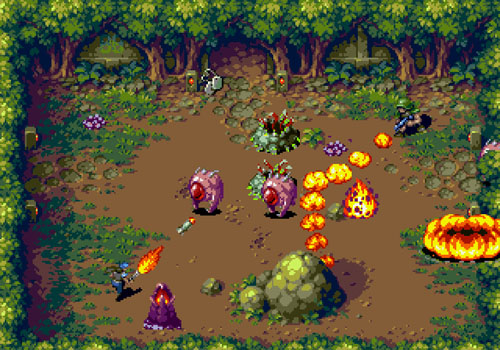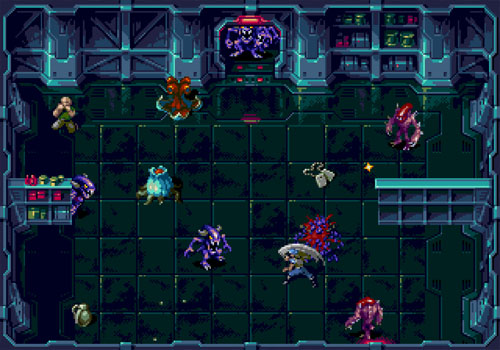A game by Bitmap Bureau for PC, Mac, Linux, PS4, Xbox One, Switch, Sega Genesis, DC, and Neo Geo, originally released in 2019.
Xeno Crisis is a top-down arena shooter starring a male or female marine – or both in 2P co-op – who are ordered to infiltrate Outpost 88. The research station is orbiting Jupiter’s moon of Io, and the scientists on board have issued a distress call, apparently due to some kind of alien presence. Upon arriving at the space station, the marines encounter hordes of alien creatures coming from every corner, and so they do what they do best: unleash copious sprays of machine gun fire into their ugly faces.Gameplay takes place across seven themed areas, ranging from metallic space station corridors, to alien-infested biomechanical areas, and even to forest and desert biomes. The layouts of these areas are procedurally arranged, but that doesn’t factor into gameplay overmuch, given that players generally move from one room to the next, occasionally collecting keycards and backtracking a couple of rooms in order to push forward. There is no map, but the simple level layouts make such a feature unnecessary.
The game offers two difficulty levels: Easy and Hard. Hard is the default difficulty setting and presents a significant challenge. Easy mode offers enemies with less health, more medkit drops, and a higher number of dogtags, which act as the game’s currency. The player has temporary invincibility when taking damage, but the player’s onscreen avatar does not react to getting hit, nor is there an accompanying sound effect, which can make it difficult for the player to notice that he is taking damage, particularly when surrounded by enemies. In addition, enemy projectiles are quite small and not terribly bright, making them occasionally blend into the background during action-heavy sequences.
The player can take several hits before being killed, and in 2P co-op, one player can revive the other when he dies, which brings him back with one unit of health. Also, even if the player barely limps to the end of the level, he begins the next level with full health, ammo, and grenades. Getting killed allows the player to respawn on the spot, but he only has three continues… unless he purchases more. Otherwise, depleting his entire stock of continues sends the player back to the start of the game to try again from scratch.
The two marines have slightly different starting stats, with the male marine being a bit slower but able to carry more ammo. Collecting dogtags allows the player to purchase upgrades between levels to increase his maximum health, weapon power, movement speed, or ammo capacity. In addition, the player can increase his starting stock of grenades, buy a gas mask to protect him from gas attacks, or even purchase a continue for a high price.
Players are able move and aim independently, per genre standards, and aiming is locked to eight directions. The player has a limited stock of grenades, with grenade pickups occasionally spawning in the arena. Getting up close to enemies allows the player to perform a swipe with the butt of his weapon, but it’s preferable to keep a safe distance from most foes. Players are also able to perform a dodge roll to move quickly out of danger, which is helpful when players find themselves surrounded by enemies or backed into a corner.
The default machine gun fires quickly, but it does not have unlimited ammo. Instead, once the weapon’s magazine is nearly depleted, an ammo box spawns somewhere on the playfield and must be collected in order to reload. This runs counter to most arena-based shooters, which tend to have infinite ammo default weapons, but it does add a bit of strategy and some risk vs. reward as players need to be wary of their weapon use and sometimes make desperate dashes toward ammo pickups.
The player occasionally finds other weapons lying around, each of which operates on a 20-second timer (or they can be manually discarded). The player is free to use these special weapons as much as he likes, but he reverts back to the default machine gun once the timer runs out. Special weapons include bouncing projectiles, a 3-way shot, a shotgun blast, a heavy-duty Vulcan cannon, projectiles with moderate homing, lasers that shred even the most powerful enemies, rocket launchers with moderate splash damage, and a powerful short-range flamethrower. There’s even a BFG, but it’s somewhat more difficult to use given that it must be charged (versus auto-fire for the rest of the weapons), but it can slice through an entire row of baddies, killing them all in one shot.
As with many alien-themed shooters, creature designs borrow heavily from the works of H.R. Giger and the Alien franchise. The player occasionally finds Alien-esque eggs that spawn sluglike creatures, and there are a few creatures resembling xenomorphs. In general, alien designs are menacing and occasionally grotesque. Enemies offer a range of behaviors, and their bright colors and unique designs make it easy for the player to determine where to prioritize his fire.
Early on, most enemies enter from one of the doorways, swarming the room in large numbers and heading directly toward the player, similarly to basic enemies in Smash T.V. Later, some enemies are able to climb up through openings in the floor, drop down from the ceiling, or dig up from underground.
Some enemies toss projectiles or gas bombs, some are stationary while others hop about, some run around on the ground, and there are a few flying foes as well. Burrowing enemies in particular are difficult to deal with because they cannot be damaged while underground, but the player needs to be mindful of their movements so he can avoid running into them and aim some bullets their way when they do pop up.
New enemy types are introduced in each area, with previous enemies returning, slowly layering on the strategies needed to defeat them. That said, some of the later levels feature wave-after-wave of the same enemies, which occasionally makes combat tiresome. This is not helped by the fact that players must begin the game again from scratch if they burn through all of their continues.
Some levels end with dedicated boss encounters, while others simply offer a swarm of regular enemies. Boss encounters are intense, featuring hulking monstrosities that deliver heavy attacks and/or move quickly around the room. These bosses feature clear weak points for the player to focus his fire, and while they do feature long health bars, it’s possible for players to learn boss’ strategies in order to avoid most attacks. Boss battles play out somewhat differently depending on whether the player focused his upgrades on firepower, ammo capacity, or speed, as he may be better equipped to dodge attacks or to dish out heavy damage.
Aesthetically, the game offers a 4:3 presentation, similar to classic console games, with a HUD filling out the rest of the space on a 16:9 display. The game is presented in a chunky pixel style with bright colors and distinct enemy designs, along with a synthy soundtrack. Despite the somewhat serious tone, the game features an announcer that yells out the names of weapons as they are picked up, or things like “watch out” or “room clear” depending on the situation, but this option may be toggled off in the Options menu. While there is no score presented in the HUD, players do gain points from each enemy killed or hostage rescued, as well as bonus points for grabbing a medkit while at full health or a grenade while at full capacity, and each level ends with a score display and letter grade.
2D CRED
Xeno Crisis was developed by Bitmap Bureau, a studio based in the Southampton, UK and founded in February of 2016. The team includes Mike Tucker (Super House of Dead Ninjas), Matthew Cope, Catherine Menabde (198X), artist Henk Nieborg (Shakedown: Hawaii, Fox n Forests, Mighty Switch Force!, Shantae: Risky’s Revenge, Contra 4, Gunlord) and music from Savaged Regime that was developed on the Yamaha YM2612 sound chip in order to create authentic synth sounds. The game was funded in part by a successful Kickstarter campaign, which also featured physical releases of the game on the Sega Genesis and Dreamcast systems. Bitmap Bureau previously developed Ninja Shodown and the 88 Heroes series.


























0 comments:
Post a Comment